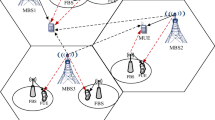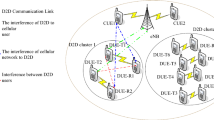Abstract
Device-to-device (D2D) communication has emerged as a promising concept to improve resource utilization in fifth generation cellular networks. D2D network’s architectural capability to offload traffic from the backhaul network to direct links enables it to be used for internet of things (IoT) services. In a densely deployed setting of IoT devices, D2D network may experience critical interferences due to a limited number of spectral resources. To increase the overall signal-to-interference-plus-noise ratio (SINR) of the network while reducing the computational load on a macro base station, a novel decentralized interference management methodology is proposed for dense in-band D2D underlay LTE-A network. The proposed interference management scheme can decouple interference in a network into cross-cluster and intra-cluster interference and tackle with them separately. To mitigate the cross-cluster interference in a dense D2D network we propose dividing the densely deployed D2D user equipments (UEs) network into well-separated clusters using spectral clustering with modified kernel weights. The proposed spectral clustering scheme obtains well-separated clusters with regards to cross-cluster interference, that is, the UEs that offer maximum interference to each other are grouped into the same cluster. Thereafter, a dynamic resource allocation algorithm is proposed within each cluster to reduce the intra-cluster interference. The proposed dynamic resource allocation algorithm uses graph coloring to allocate resources in such a manner that after each spectrum allocation, a small cell base station updates the interference graph and assigns the next largest interference affected UE a spectrum resource that minimizes the overall intra-cluster interference the most. In conventional graph coloring, the adjacent UEs are allocated different spectrum resources without taking into consideration if the allocated spectrum resource might result in increased interference in the cluster. The simulation results show that the proposed clustering strategy considerably reduces the average cross-cluster interference as compared to other benchmark clustering algorithms such as K-means and KPCA. Moreover, the proposed resource allocation algorithm decreases the intra-cluster interference in the network resulting in the overall SINR maximization of the network.






Similar content being viewed by others
References
Ericsson mobility report. Ericsson. [online]. Available: https://www.ericsson.com/assets/local/mobility-report/documents/2019/emr-q4-update-2018.pdf. Accessed 1 Feb 2019.
Cisco visual networking index: Global mobile data traffic forecast update, 2017–2022 white paper. Cisco. [online]. Available: https://www.cisco.com/c/en/us/solutions/collateral/service-provider/visual-networking-index-vni/white-paper-c11-738429.html. Accessed 18 Feb 2019.
Mach, P., Becvar, Z., & Vanek, T. (2015). In-band device-to-device communication in OFDMA cellular networks: A survey and challenges. IEEE Communications Surveys and Tutorials, 17(4), 1885–1922.
Noura, M., & Nordin, R. (2016). A survey on interference management for device-to-device (D2D) communication and its challenges in 5G networks. Journal of Network and Computer Applications, 71, 130–150.
Jerew, O., & Al Bassam, N. (2019). Delay tolerance and energy saving in wireless sensor networks with a mobile base station. Wireless Communications and Mobile Computing, 2019, 3929876. https://doi.org/10.1155/2019/3929876.
Zhao, L., Wang, H., & Zhong, X. (2018). Interference graph based channel assignment algorithm for D2D cellular networks. IEEE Access, 6, 3270–3279.
Lin, Y., Zhang, R., Li, C., Yang, L., & Hanzo, L. (2018). Graph-based joint user-centric overlapped clustering and resource allocation in ultradense networks. IEEE Transactions on Vehicular Technology, 67(5), 4440–4453.
Lin, S., Ni, W., Tian, H., & Liu, R. P. (2015). An evolutionary game theoretic framework for femtocell radio resource management. IEEE Transactions on Wireless Communications, 14(11), 6365–6376.
Chun, Y. J., Hasna, M. O., & Ghrayeb, A. (2015). Modeling heterogeneous cellular networks interference using Poisson cluster processes. IEEE Journal on Selected Areas in Communications, 33(10), 2182–2195.
Dai, J., & Wang, S. (2016). Clustering-based interference management in densely deployed femtocell networks. Digital Communications and Networks, 2(4), 175–183.
Zhang, Y., Zheng, J., Lu, P.-S., & Sun, C. (2017). Interference graph construction for cellular D2D communications. IEEE Transactions on Vehicular Technology, 66(4), 3293–3305.
Hassan, Y., Hussain, F., Hossen, S., Choudhury, S., & Alam, M. M. (2017). Interference minimization in D2D communication underlaying cellular networks. IEEE Access, 5, 22471–22484.
Gandotra, P., Jha, R. K., & Jain, S. (2017). A survey on device-to-device (D2D) communication: Architecture and security issues. Journal of Network and Computer Applications, 78, 9–29.
Handy, M. J., Haase, M., & Timmermann, D. (2002). Low energy adaptive clustering hierarchy with deterministic cluster-head selection. In 4th international workshop on mobile and wireless communications network (pp. 368–372). IEEE.
Qiao, Y., Shi, C., Wang, C., Li, H., Haberland, M., Luo, X., et al. (2019). Uncertainty quantification for semi-supervised multi-class classification in image processing and ego-motion analysis of body-worn videos. In Proceedings on electronic imaging 2019.
Newman, M. E. J., Watts, D. J., & Strogatz, S. H. (2002). Random graph models of social networks. Proceedings of the National Academy of Sciences, 99(1), 2566–2572. [online].
Kannan, R., Vempala, S., & Vetta, A. (2004). On clusterings: Good, bad and spectral. Journal of the ACM (JACM), 51(3), 497–515.
Von Luxburg, U. (2007). A tutorial on spectral clustering. Statistics and Computing, 17(4), 395–416.
Jabłoński, I. (2017). Graph signal processing in applications to sensor networks, smart grids, and smart cities. IEEE Sensors Journal, 17(23), 7659–7666.
Van Mieghem, P. (2010). Graph spectra for complex networks. Cambridge: Cambridge University Press.
Tibshirani, R., Walther, G., & Hastie, T. (2001). Estimating the number of clusters in a data set via the gap statistic. Journal of the Royal Statistical Society: Series B (Statistical Methodology), 63(2), 411–423.
Author information
Authors and Affiliations
Corresponding author
Additional information
Publisher's Note
Springer Nature remains neutral with regard to jurisdictional claims in published maps and institutional affiliations.
Rights and permissions
About this article
Cite this article
Kasi, S.K., Naqvi, I.H., Kasi, M.K. et al. Interference management in dense inband D2D network using spectral clustering & dynamic resource allocation. Wireless Netw 25, 4431–4441 (2019). https://doi.org/10.1007/s11276-019-02107-2
Published:
Issue Date:
DOI: https://doi.org/10.1007/s11276-019-02107-2




